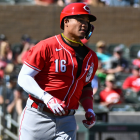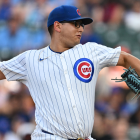 |
| Michael Bourn's ability to produce runs and get on base significantly improves his value as a free agent. (US Presswire) |
How much do teams really value speed and defense? That question should be answered this offseason once Michael Bourn hits the market. Over the past five seasons, Bourn has grown into one of the game’s elite center fielders. This winter, he’s sure to be one of the top free agents available, and should receive a lucrative contract. But Bourn is very different from the typical elite free agent. Bourn isn’t a run producer, and his ability to hit the long-ball is nonexistent. Much of Bourn’s value comes from his strong base-running skills and his exceptional defense in center. In past years, it’s been rare to see elite defensive players receive huge contracts. But the game has changed, and defense is now being stressed more than ever.
By most measures, Bourn is just a league-average hitter. His wOBA, an advanced stat that measures offensive performance, has fluctuated between slightly below-average and slightly above-average over the last five seasons. Bourn is capable of hitting for decent averages and is capable of posting decent walk rates, but his lack of power hurts his value at the plate. Since he became a full-time starter, Bourn has a .324 wOBA. That puts him in the same company as Chris Coghlan, Conor Jackson, Jonathan Lucroy and Scott Podsednik. Those aren’t the type of players that are going to make a lot of money on the free-agent market.
But when you account for Bourn’s defense and base-running, his value rises considerably. Bourn has been a spectacular defensive center fielder over his career, racking up a 48.3 ultimate zone rating, or UZR, over the past five years. That figure rates Bourn as the seventh strongest defensive player in baseball, and the third best defensive center fielder.
Bourn’s performance on the base paths also plays a significant role in his value. Bourn is already known as one of the game’s prolific base stealers, but he’s also one of the game’s smartest base runners, according to ultimate base running (UBR). UBR measures a player’s performance on the base paths. It looks at how often players are able to successfully advance an extra base and penalizes players for making poor decisions while running the bases. Since he became a full-time player, Bourn leads all of baseball with a 21.1 UBR. That means that Bourn has produced 21 more runs than the average player on the bases.
When those aspects are factored into his performance, Bourn emerges as one of the top outfielders of the era since he became a full-time starter. Bourn’s 20.3 WAR over the past five years ranks him 10th among all outfielders, tied with Curtis Granderson and just ahead of Carlos Beltran and Jayson Werth. Those players offer a much more accurate sample of how Bourn will be valued on the market.
At the same time, Bourn’s skill set doesn’t typically get rewarded with big contracts on the market. From a defensive standpoint, a player who compares pretty favorably to Bourn is Placido Polanco. Both players produced a similar amount of value by their age-29 seasons, and both did it with elite defensive skills. Near the end of the 2005 season, Polanco signed a four-year, $18.4 million extension to stay with the Tigers. It’s important to note that players who hit the free agent market typically receive larger contracts than players who sign extensions. When more teams are in on the bidding process, a player has more leverage and can get larger deals. In this case, that $18.4 million is nowhere close to what Bourn is expected to receive this year. But it’s an example of elite defensive players not getting paid like they should.
One of the better comparisons for Bourn is Carl Crawford, but there’s no way Bourn will receive a deal in the range of the seven-year, $142 million deal Crawford received. It’s not a perfect comparison, as Crawford hit the market a year younger than Bourn, and, at that time, Crawford was the superior player. But like Bourn, much of Crawford’s value came from his ability to play great defense and utilize his speed.
While their playing styles differ quite a bit, the best comparison for Bourn is probably Aaron Rowand. Both players reached free agency at the same point in their careers, played the same position and produced similar value. Bourn's 20.3 WAR just slightly edges out Rowand, who had accumulated 18.9 WAR once he became a free-agent. Rowand was also an effective fielder and base runner, which is helpful in this scenario. Though he was nowhere near as effective as Bourn, he still managed to add value in both areas. For his performance, Rowand received a five-year, $60 million contract from the Giants.
Considering all the factors, a yearly salary between $11 million and $12 million would make sense for Bourn. At the same point in their careers, Bourn is a better player than Rowand, and deserves to be paid as such. But while those numbers are more than fair, it will be interesting to see if teams are willing to shell out that much money for a player whose value is so dependent on defense and speed. In recent seasons, we’ve seen managers employ more defensive shifts, and general managers talk about the importance of a strong defense more than ever. With Michael Bourn, we’ll be able to see exactly how much these teams really value those skills.
*For better explanations of the advanced stats used in this article, I would recommend the FanGraphs library, which can be found here.
Possible suitors: Braves, Rangers, Giants
Long shots: Mariners, Indians
For more up-to-the-minute news and analysis on the latest rumors from bloggers Chris Cwik, Jack Moore and R.J. White, follow @MLBRumorsCBS.
















